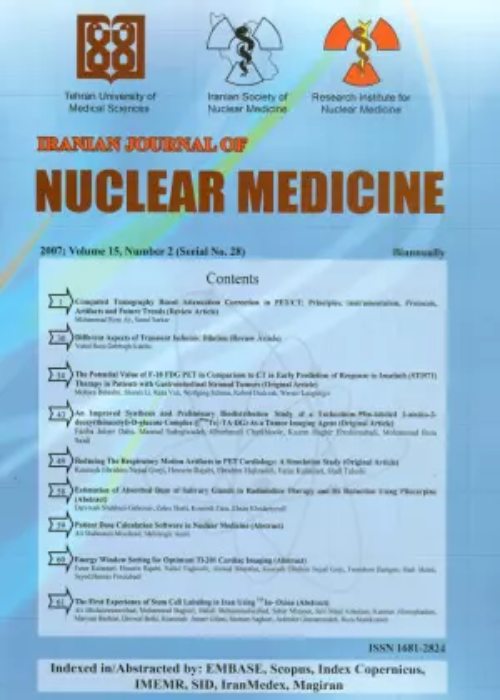Energy Window Setting for Optimum Tl-201 Cardiac Imaging
Author(s):
Abstract:
Introduction
Poor sensitivity and poor signal to noise ratio because of low injected thallium dose and presence of scattered photons are the main problems in using thallium in scintigraphic imaging of the heart. Scattered photons are the main cause of degrading the contrast and resolution in SPECT imaging that result in error in quantification. Thallium decay is very complicated and photons are emitted in a wide range of energies of 68-82 keV. It seems possible to achieve better primary to scattered radiation ratio and better image sensitivity simultaneously if the energy window setting is carefully selected.Methods
This investigation was performed in three steps: Monte Carlo simulation, phantom experiment and clinical study. In simulation step, the new 4D digital NCAT phantom was used to simulate the distribution of activity (201Tl) in patient torso organs. The same phantom was used to simulate the attenuation coefficient of different organs of the typical patient''s body. Two small defects on different parts of left ventricle also were generated for further quantitative and qualitative analysis. The simulations were performed using the SimSET simulator to generate images of such patient. The emissions arising from Tl-201 decay were simulated in four steps using the energies and relative abundances. Energy spectra for primary and scatter photons were calculated. Changing the center and width of energy windows, optimum energy window characteristics were determined. In next step jaszczak phantom was prepared and used for SPECT imaging in different energy windows. In last step SPECT images of 7 patients who had angiographic data were acquired in different energy windows. All of these images were compared qualitatively by four nuclear medicine physicians independently.Results
The optimum energy window was determined as a wider asymmetric window (77keV30%) that its center is not placed on photo-peak of energy spectrum. This window increased the primary counts rate and PTSR considerably as compared with the conventional symmetric energy window (67keV%). In a comparison which performed between clinical images acquired in suggested 77-30% window with conventional 67-20% window, a considerable increase was found in myocardial to defect contrast (1.541±0.368) and myocardial to cavity contrast (1.171± 0.099). A negligible increase was also found in total counts of images using this window. Conclusion
We found that conventional symmetric energy window (67keV± 10%) couldn''t be a suitable choice for thallium heart imaging; furthermore three energy windows, 73keV-30%, 75keV-30% and 77keV-30%, were determined as optimum window options. For further analysis the images from such windows were compared in each three steps of this investigation. In all steps conventional symmetric energy window (67keV-20%) was introduced as the worst case and the asymmetric 77keV-30% was determined as the most suitable.Language:
English
Published:
Iranian Journal of Nuclear Medicine, Volume:15 Issue: 2, Summer-Autumn 2007
Page:
15
https://magiran.com/p552123
دانلود و مطالعه متن این مقاله با یکی از روشهای زیر امکان پذیر است:
اشتراک شخصی
با عضویت و پرداخت آنلاین حق اشتراک یکساله به مبلغ 1,390,000ريال میتوانید 70 عنوان مطلب دانلود کنید!
اشتراک سازمانی
به کتابخانه دانشگاه یا محل کار خود پیشنهاد کنید تا اشتراک سازمانی این پایگاه را برای دسترسی نامحدود همه کاربران به متن مطالب تهیه نمایند!
توجه!
- حق عضویت دریافتی صرف حمایت از نشریات عضو و نگهداری، تکمیل و توسعه مگیران میشود.
- پرداخت حق اشتراک و دانلود مقالات اجازه بازنشر آن در سایر رسانههای چاپی و دیجیتال را به کاربر نمیدهد.
In order to view content subscription is required
Personal subscription
Subscribe magiran.com for 70 € euros via PayPal and download 70 articles during a year.
Organization subscription
Please contact us to subscribe your university or library for unlimited access!


